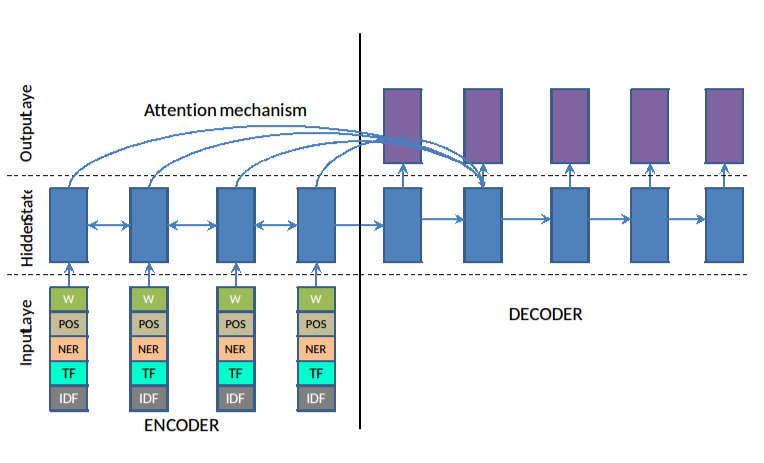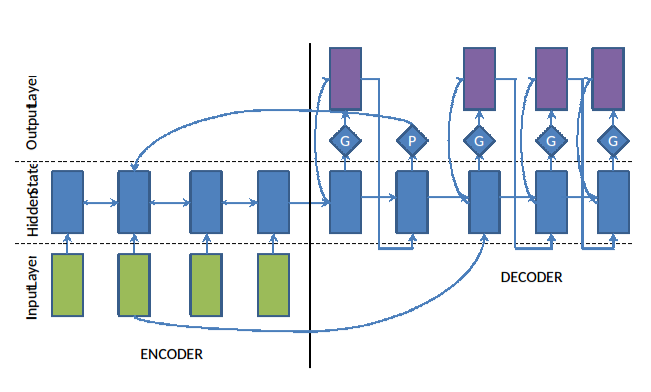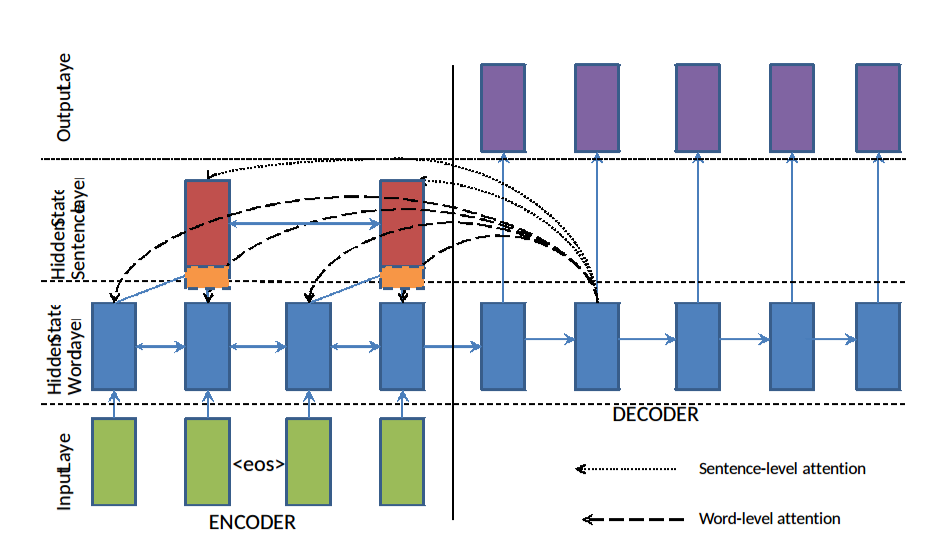Nallapati, et al (IBM Watson)
Hypothesis
- Modeling abstractive text (sentence) summarization using Attentional Encode Decoder neural nets. Propose models for handling out of word vocabulary, hierarchical structure, and adding features in the encoder.
Interesting methods
- Based on the standard Encoder-Decoder framework with attention, they propose a few additional extensions.
- Large Vocab Trick, instead of softmax over the entire vocabulary, softmax over the vocabulary from the source document as well as the top frequent words in the vocabulary.
- Capturing Keywords using feature-rich Encoder: Concatenate the word vectors in the source with TF, IDF features as
 3- Handling Out of Vocabulary terms by pointing the decoder to a location in the source document instead of generating a new word. A switch at each time step decides whether to point to a source document word or generate a new word. It is modeled as a sigmoid function over a linear layer on the context at each time step.
3- Handling Out of Vocabulary terms by pointing the decoder to a location in the source document instead of generating a new word. A switch at each time step decides whether to point to a source document word or generate a new word. It is modeled as a sigmoid function over a linear layer on the context at each time step.
 4- Hierarchical attentions for capturing hierarchical document structure: Two RNNs on the source side, one at word level and the other at the sentence level. Attention operates at both levels simultaneously. Word attention is re-weighted by the corresponding sentence-level attention and re-normalized as:
\(P^(a)(j)=\frac{P^a_w(j)P^a_s(s(j))}{\sum\levels_{k=1}^{N_d}P^a_w(k)P^a_s(s(k))}\)
$P^a_w(j)$ is the word-level attention weight at $j^{th}$ position of the source document, $P^a_s(s(j))$ is the sentence-level attention weight for the sentence at the $j^{th}$ position. $N_d$ is the number of words in the source document, and $P^a(j)$ is the re-scaled attention at the $j^th$ word position.
4- Hierarchical attentions for capturing hierarchical document structure: Two RNNs on the source side, one at word level and the other at the sentence level. Attention operates at both levels simultaneously. Word attention is re-weighted by the corresponding sentence-level attention and re-normalized as:
\(P^(a)(j)=\frac{P^a_w(j)P^a_s(s(j))}{\sum\levels_{k=1}^{N_d}P^a_w(k)P^a_s(s(k))}\)
$P^a_w(j)$ is the word-level attention weight at $j^{th}$ position of the source document, $P^a_s(s(j))$ is the sentence-level attention weight for the sentence at the $j^{th}$ position. $N_d$ is the number of words in the source document, and $P^a(j)$ is the re-scaled attention at the $j^th$ word position.

Results
- Gigaword, DUC, CNN/Daily Mail
- slight improvements over Rush et al. 2015
 3- Handling Out of Vocabulary terms by pointing the decoder to a location in the source document instead of generating a new word. A switch at each time step decides whether to point to a source document word or generate a new word. It is modeled as a sigmoid function over a linear layer on the context at each time step.
3- Handling Out of Vocabulary terms by pointing the decoder to a location in the source document instead of generating a new word. A switch at each time step decides whether to point to a source document word or generate a new word. It is modeled as a sigmoid function over a linear layer on the context at each time step.
 4- Hierarchical attentions for capturing hierarchical document structure: Two RNNs on the source side, one at word level and the other at the sentence level. Attention operates at both levels simultaneously. Word attention is re-weighted by the corresponding sentence-level attention and re-normalized as:
\(P^(a)(j)=\frac{P^a_w(j)P^a_s(s(j))}{\sum\levels_{k=1}^{N_d}P^a_w(k)P^a_s(s(k))}\)
$P^a_w(j)$ is the word-level attention weight at $j^{th}$ position of the source document, $P^a_s(s(j))$ is the sentence-level attention weight for the sentence at the $j^{th}$ position. $N_d$ is the number of words in the source document, and $P^a(j)$ is the re-scaled attention at the $j^th$ word position.
4- Hierarchical attentions for capturing hierarchical document structure: Two RNNs on the source side, one at word level and the other at the sentence level. Attention operates at both levels simultaneously. Word attention is re-weighted by the corresponding sentence-level attention and re-normalized as:
\(P^(a)(j)=\frac{P^a_w(j)P^a_s(s(j))}{\sum\levels_{k=1}^{N_d}P^a_w(k)P^a_s(s(k))}\)
$P^a_w(j)$ is the word-level attention weight at $j^{th}$ position of the source document, $P^a_s(s(j))$ is the sentence-level attention weight for the sentence at the $j^{th}$ position. $N_d$ is the number of words in the source document, and $P^a(j)$ is the re-scaled attention at the $j^th$ word position.
